Ideas
How The NEP Places Innovation At The Epicentre Of The Indian Education System
Dr Abhay Jere
Nov 17, 2019, 02:11 PM | Updated Nov 18, 2019, 05:36 PM IST
Save & read from anywhere!
Bookmark stories for easy access on any device or the Swarajya app.


In India, innovation is still not the epicentre of the education system. In order to achieve the required cultural and attitudinal shift, and to ensure that the ‘Innovation, Startup and Entrepreneurship’ culture emerges as the primary fulcrum of our higher education system, a comprehensive overhauling of our Indian education is necessary. And, this must be in line with Bloom’s taxonomy framework, which is used globally.
The Bloom's taxonomy framework is a hierarchical/pyramid model, which is most widely used to classify educational achievements. It consists of six major levels based on complexity and specificity and each level depends on the one below.
‘Remember’ is the basic or lowest order skill, while ‘Create’ is the highest order learning skill.
It is believed that students move up through each level of this pyramid as they acquire deeper knowledge of a subject.
Unfortunately, our education system focusses substantially on rote learning and is more into ‘swallow and vomit’ mode. Hence, our students get stuck at sub-optimal thinking levels.

As a result, cognitive skills or higher-order thinking skills of our students are quite poor. A majority of them are not very capable of thinking independently and very few are capable of thinking out-of-the-box.
This also reflects in lower self-esteem and confidence levels, which ultimately results in lower risk-taking ability, which is crucial for entrepreneurship. Thus, a majority of our students are simply in ‘job-seeking’ mode rather than ‘job-creating’ mode.
This fact got further re-emphasised by a recent study done by the World Bank and Stanford University on our engineering students. They surveyed roughly 5,000 engineering students from 200 randomly-selected public and private engineering institutes.
These 200 institutes did not include the IITs. Similar learning assessments were also conducted for engineering students in China and Russia. The study showed that Russian and Chinese engineering students are better than those in India.
Although, Indian students make substantial gains in mathematics and critical thinking skills in the first two years of their engineering education, as compared to their counterparts in China and Russia, their overall higher-order thinking skills are substantially lower than the Chinese and Russians.
If a large chunk of our technical students are not on a par with global standards, then it’s a no-brainer to guess the quality of our enormous pool of youth.
The proposed new National Education Policy (NEP) is certainly making an attempt to address these challenges. It has proposed some radical changes both at the school level and at the higher education level.
Ever since the draft policy was put out in the public domain, it has triggered a lot of discussions and debates. The Ministry of Human Resource Development (MoHRD) is very sensitive towards these suggestions and is planning to incorporate many of them in the revised version which will be released soon.
If India has to innovate, then we need to make every possible effort to develop higher- order thinking skills of our youngsters.





